| Article ID | Journal | Published Year | Pages | File Type |
|---|---|---|---|---|
| 66790 | Journal of Molecular Catalysis A: Chemical | 2010 | 6 Pages |
Chitosan was modified through the hydrogel synthesis route and its catalytic activity was evaluated for the synthesis of jasminaldehyde by the condensation of 1-heptanal with benzaldehyde under solvent-free conditions. Chitosan being natural product and also the solvent-free synthesis procedure of jasminaldehyde have the advantage of green catalysis. Maximum conversion of >99% and 88% selectivity to jasminaldehyde were obtained at 160 °C. The effect of reaction parameters such as the amount of the catalyst, temperature and the benzaldehyde to 1-heptanal molar ratio on the conversion and selectivity was studied. The catalyst was recycled up to six times without significant loss in its activity and selectivity.
Graphical abstractJasminaldehyde is a perfumery chemical of commercial interest and is synthesized under solvent-free conditions by the condensation of 1-heptanal with benzaldehyde in the presence of an eco-friendly solid base catalyst, chitosan. The condensation depended on the catalyst amount, 1-heptanal to benzaldehyde ratio, and temperature and the catalyst was recycled effectively.Figure optionsDownload full-size imageDownload high-quality image (33 K)Download as PowerPoint slide
